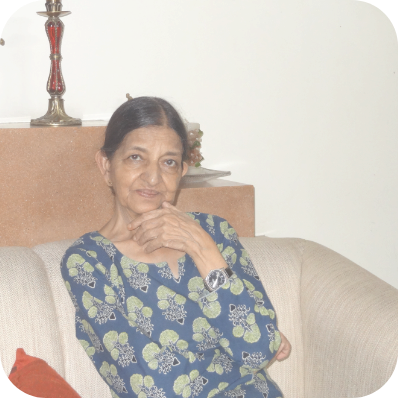
Madhu Sarin
Madhu Sarin is a trained architect and a passionate social activist. After studying architecture, she went on a scholarship to Italy on a programme called ‘Experiment on International Living’. Following that she worked in London for a decade before returning to India.
INTERVIEWEES
Madhu Sarin
Education and early interests
Education and early interests
Summary:
Madhu Sarin begins the conversation by describing her beginnings on her journey with architecture and the subsequent phases. From a very early age, she was clear that she wanted to pursue a professional degree after she observed that only a professional degree would allow her to stand independently. She goes into detail on the other factors that led to her choosing architecture. Talking about her college days, she goes on in detail about her performance, competitive projects, and being one of the few women in her class. She describes the time she got selected to pursue a program abroad, where she immersed herself in the culture and architecture of Italy and stayed behind to pursue a job. She goes into the experiences she had during the time as she traveled, met new people, and made her living in a new country for the first time. She further pursued a postgraduate degree at the now Development Planning Unit, under the University College London (UCL), and went on to join them as a research scholar and teacher. Subsequently, she received a research grant to undertake a study on Chandigarh’s planning, which led to her writing a book titled “Urban Planning in the Third World”, after putting in two years of fieldwork on it. This led her to move on from architectural planning to developing an interest in and focus on rural development and sustainable resource management. Moreover, she set up the Village Resources Management Society in an initiative of undertaking projects of larger environmental issues. She describes her learnings, challenges, the core people involved from the widely recognized Sukhomajri initiative from the 1980s, and the Ford Foundation involvement. She details and draws a timeline of her involvement and talks about the time she stood as a member of the drafting committee of the initiative. She concludes by drawing from her experiences of shifting pathways from architecture to environmental management, people’s rights over natural resources, and the recent developments in her journey.
Practitioner:
Madhu Sarin
Interviewee:
Madhu Sarin
Interviewer:
Ishita Shah
Duration:
00.44.06
Mode:
Offline
Date:
12/08/2021
Language:
English
English
Highlights:
(00:00:46) Growing up in Shimla , (00.01.55) My father was a lawyer and it was not for me , (00:03:09) Belonging to the 2nd batch of Chandigarh College of Architecture (CCA), (00:05:08) Italy's programme on experiments with International living, (00:13:21) Becoming a research scholar and then a Teacher at the Development Planning Unit , (00:15:36) The Sukhomajri village project
(00:00:46) Growing up in Shimla , (00.01.55) My father was a lawyer and it was not for me , (00:03:09) Belonging to the 2nd batch of Chandigarh College of Architecture (CCA), (00:05:08) Italy's programme on experiments with International living, (00:13:21) Becoming a research scholar and then a Teacher at the Development Planning Unit , (00:15:36) The Sukhomajri village project
Formative years and early practice
Formative years and early practice
Summary:
Madhu Sarin recalls the years she spent growing up in Shimla and Chandigarh. Her parents were refugees from West Pakistan and had moved to Shimla, where she stayed till the age of nine. She describes her fond memories of growing up in Shimla and then disliking the sudden move to Chandigarh in 1955 and her first home there. She details her personal relationships with her immediate family members, and her observations about their individual careers and their impact on her career decision. She talks about her perspectives on the concept of arranged marriage and how she had narrowly avoided being pressured into one because she wasn’t in the country. Furthermore, she describes her experiences graduating with a degree in Architecture at the Chandigarh College of Architecture (CCA) as one of the only girls on campus. She recalls her fondest relationships with a few professors and her difficulties in studying. For her thesis, she describes her field visits to slums and squatter settlements. Once she started practicing, she soon began to pursue taking on more than just designer-building projects due to personal inclinations. In her practical study, she got the chance to train under B V Doshi in Ahmedabad, having to do basic drafting and so enjoying the experience of staying away from home. She speaks more about the experience at B V Doshi’s office, and about her inherent inclinations towards low-cost housing and developmental projects from when she was a student. On famous architects she looked up to during her study till recently, she talks of the pivotal practices of and brief interactions with Le Corbusier, Urmila Eulie Chowdhury, B P Mathur, Charles Correa, and B V Doshi, that made a mark on her life. Concluding with her impressions of Chandigarh’s city plan, she explains how the physical development of a city reflects the socio-economic structure of a society.
Practitioner:
Madhu Sarin
Interviewee:
Madhu Sarin
Interviewer:
Ishita Shah
Duration:
00.48.51
Mode:
Offline
Date:
12/08/2021
Language:
English
English
Highlights:
(00:01:33) Childhood in Shimla and being slapped by monkeys , (00:09:48) Thoughts on arranged marriage , (00:25:20) Designing the Chief Engineer's house, (00:40:12) Reactions and responses towards Le Corbusier's architecture
(00:01:33) Childhood in Shimla and being slapped by monkeys , (00:09:48) Thoughts on arranged marriage , (00:25:20) Designing the Chief Engineer's house, (00:40:12) Reactions and responses towards Le Corbusier's architecture
Practice and nclinations
Practice and nclinations
Summary:
While talking about the short stint of setting up her architecture office, she details the beginnings of her six-month short journey with her co-partners, and the important projects the office took on in the early years. Remarking on her practice as a woman architect in the field, she recalls experiences she had in and outside the office. She shares her fondest experiences from working and training abroad and the relatively greater freedoms she enjoyed. She noticed her inclinations beginning to shift from architecture toward socio-economic planning and developmental issues after she moved to London from Italy on a whim in 1968. She first worked in the Public Works Department, then at an architectural firm, in order to financially sustain herself, and soon after, started her postgraduate study for which she raised funds independently. In the process, she made many instrumental acquaintances. On her tutors at college in London, she recalls the shift she experienced in the traditional teacher-student dynamics she was used to from back home. She mentions the collaborations and initiatives she participated in with groups in the many global opportunities offered then. She further speaks about her brief interactions with the Head of the Department at UCL, Dr. Otto H Königsberger. After her first year of study, she took on a job immediately to support herself. On returning to Chandigarh after receiving a research grant, she focussed her efforts on studying unplanned settlements, and urban planning issues, which were also later addressed in her book. The Department of Development grant research paved the way for her book, recommended in architecture school curriculums. She remembers the reasons why she decided to apply for the grant, the process that led up to her selection, and the book’s reception.
Practitioner:
Madhu Sarin
Interviewee:
Madhu Sarin
Interviewer:
Ishita Shah
Duration:
00.46.03
Mode:
Offline
Date:
14/08/2021
Language:
English
English
Highlights:
(00:00:43) Setting up a collaborative practice with batchmates , (00:10:00) The time I let my hair down: the experience of living independently and away from home, (00:23:47) The experience of studying at AA, (00:34:44) Receiving a research grant to study Chandigarh's planning
(00:00:43) Setting up a collaborative practice with batchmates , (00:10:00) The time I let my hair down: the experience of living independently and away from home, (00:23:47) The experience of studying at AA, (00:34:44) Receiving a research grant to study Chandigarh's planning
Partnerships and popular projects
Partnerships and popular projects
Summary:
Recalling the time she studied abroad, she mentions how she never intended on settling even though she overstayed her visit. After the study, she came back to the Punjab State Institute for Public Administration where the administrative officer persuaded her to set up an Urban Cell which she now terms a short misadventure. Afterward, she started working with the Ford Foundation project in helping the people in the Shivalik Hills with an extended involvement, which led to the Sukhomajri and Nadar projects. She led the people’s effort in the initiatives for the concern of people’s rights in 1981.
Furthermore, she shares her holistic learnings from the projects, policy-making, and technical solutions that she was involved in throughout the process. She recalls how the initiatives depended on collaborative efforts and her involvement with the ministry, where a task force was set up. She also remarked on the heavy interdepartmental support the solution implementation process relies on. On leading efforts towards the legislation of the Forest Rights Act 2006 and the basis for its drafting application she spearheaded, she goes into detail about the specificities of the injustices she experienced in the field. Discussing the educational roles she dawned, she recognizes that she didn’t have the time to dedicate herself entirely to teaching. She shares her thoughts on the conservation efforts in Chandigarh and how she plans on developing her work forward. Moreover, she reflects on the developments in the field of architecture and how it has changed for young women.
Furthermore, she shares her holistic learnings from the projects, policy-making, and technical solutions that she was involved in throughout the process. She recalls how the initiatives depended on collaborative efforts and her involvement with the ministry, where a task force was set up. She also remarked on the heavy interdepartmental support the solution implementation process relies on. On leading efforts towards the legislation of the Forest Rights Act 2006 and the basis for its drafting application she spearheaded, she goes into detail about the specificities of the injustices she experienced in the field. Discussing the educational roles she dawned, she recognizes that she didn’t have the time to dedicate herself entirely to teaching. She shares her thoughts on the conservation efforts in Chandigarh and how she plans on developing her work forward. Moreover, she reflects on the developments in the field of architecture and how it has changed for young women.
Practitioner:
Madhu Sarin
Interviewee:
Madhu Sarin
Interviewer:
Ishita Shah
Duration:
00.46.00
Mode:
Offline
Date:
14/08/2021
Language:
English
English
Highlights:
(00:00:26) The journey of coming back to India, (00:11:02) Getting women involved in village meetings and rural developmental projects
(00:00:26) The journey of coming back to India, (00:11:02) Getting women involved in village meetings and rural developmental projects
